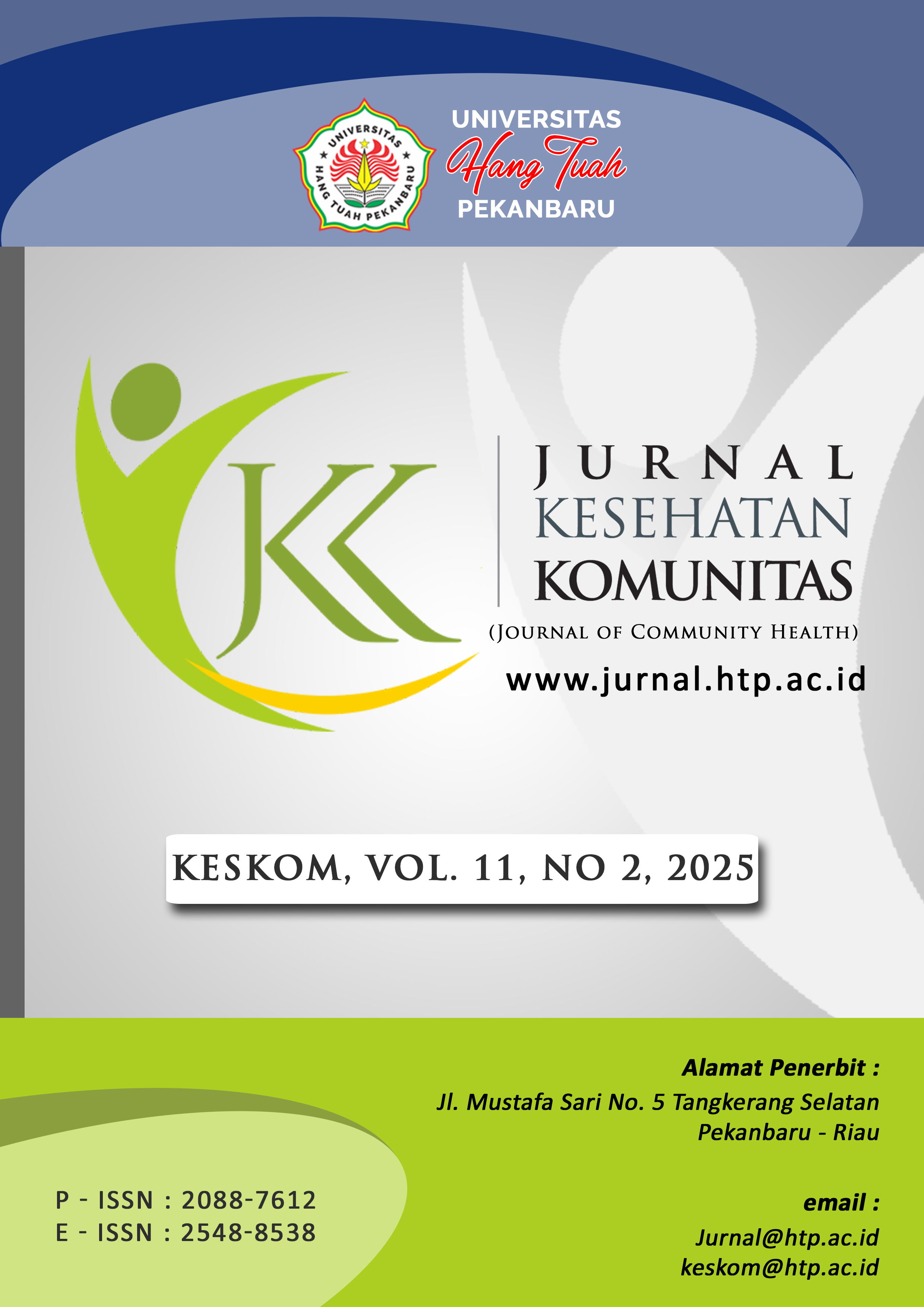The Determinants of Low Birth Weight's Babies Care in Agriculture and Coastal Areas: Family Perspective
DOI:
https://doi.org/10.25311/keskom.Vol11.Iss2.2211Keywords:
Agriculture, caring, coastal, low birth weightAbstract
Low birth weight babies (LBW) in agricultural and coastal areas have different health problems thus possibly having different care needs. Inappropriate promotion of child health, especially LBW, in both clinical and community service settings can increase morbidity and mortality rates. The purpose of this study was to identify the determinants of LBW babies care needs based on family perspectives in coastal and agricultural areas. This cross-sectional observational study was conducted in June 2023 using a questionnaire to identify the determinants of LBW’s babies care. The population of this study was children and mothers in coastal and agricultural areas. Multistage random cluster sampling with the G*Power application obtained 193 participants per region, resulting in a total sample of 386. Data were analyzed using difference in means between two regions. The results showed that agricultural regions had higher mean on LBW care, parental stress, and family empowerment. Coastal areas had higher mean scores on quality of life, maternal confidence, and food diversity practices. There was a significant difference between coastal and agricultural areas on the determinants of LBW’babies care between coastal and agricultural areas, especially on the variables of parental quality of life (p=0.000), parenting stress (p=0.029), maternal confidence (p-0.000) and family empowerment (p = 0.000). Optimizing health promotion by pediatric nurses in the scope of hospital and community settings can be achieved by empowering families and paying attention to parenting stress, maternal confidence, and parents' quality of life.
Downloads
References
[1] Kemenkes RI, Profil Kesehatan Indonesia 2020, vol. 48, no. 1. Jakarta: Kementerian Kesehatan RI.2021, 2021. doi: 10.1524/itit.2006.48.1.6.
[2] Y. Tomoyasu and I. Sobue, “Problems with Home Care of Low-birth-weight Infants: ‘Use of Little Baby Handbook’ to Support Low-birth-weight Infants and Families (Mothers),” J. Compr. Nurs. Res. Care, vol. 4, no. 1, pp. 1–5, 2019, doi: 10.33790/jcnrc1100135.
[3] C. S. Vilanova, V. N. Hirakata, V. C. De Souza Buriol, M. Nunes, M. Z. Goldani, and C. H. Da Silva, “The relationship between the different low birth weight strata of newborns with infant mortality and the influence of the main health determinants in the extreme south of brazil,” Popul. Health Metr., vol. 17, no. 1, pp. 1–12, 2019, doi: 10.1186/s12963-019-0195-7.
[4] F. A. Ogbo et al., “Determinants of trends in neonatal , post- neonatal , infant , child and under-five mortalities in Tanzania from 2004 to 2016,” pp. 1–12, 2019.
[5] J. Bater et al., “Predictors of low birth weight and preterm birth in rural Uganda: Findings from a birth cohort study,” PLoS One, vol. 15, no. 7 July, pp. 1–16, 2020, doi: 10.1371/journal.pone.0235626.
[6] O. J. Sumampouw, J. E. Nelwan, and A. A. Rumayar, “Socioeconomic factors associated with diarrhea among under-five children in Manado Coastal Area, Indonesia,” J. Glob. Infect. Dis., vol. 11, no. 4, pp. 140–146, 2019, doi: 10.4103/jgid.jgid-105-18.
[7] E. C. Keats et al., “Accelerating Kenya’s progress to 2030: Understanding the determinants of under-five mortality from 1990 to 2015,” BMJ Glob. Heal., vol. 3, no. 3, pp. 1–15, 2018, doi: 10.1136/bmjgh-2017-000655.
[8] B. Lv et al., “Family-centered care improves clinical outcomes of very-low-birth-weight infants: A quasi-experimental study,” Front. Pediatr., vol. 7, no. APR, pp. 1–6, 2019, doi: 10.3389/fped.2019.00138.
[9] A. Iva Murty, “Saving Low Birth Weight Babies with Kangaroo Mother Care: Family Resilience and Social Capital as Success Factors,” J. Mod. Educ. Rev., vol. 8, no. 9, pp. 667–672, 2018, doi: 10.15341/jmer(2155-7993)/09.08.2018/004.
[10] E. S. Astuti, N. Nursalam, S. R. Devy, and R. Etika, “Knowledge , Family Support and Self-Reliance Capital when Caring for Low Birth Weight Babies,” vol. 14, no. 1, pp. 10–15, 2019.
[11] M. Gregory, L. Kannis-Dymand, and R. Sharman, “A review of attachment-based parenting interventions: Recent advances and future considerations,” Aust. J. Psychol., vol. 72, no. 2, pp. 109–122, 2020, doi: 10.1111/ajpy.12270.
[12] T. Nordheim, T. Rustøen, A. L. Solevåg, M. C. Småstuen, and B. Nakstad, “Hope in Parents of Very-Low Birth Weight Infants and its Association with Parenting Stress and Quality of Life,” J. Pediatr. Nurs., vol. 38, pp. e53–e58, 2018, doi: 10.1016/j.pedn.2017.10.006.
[13] K. North et al., “Family Involvement in the Routine Care of Hospitalized Preterm or Low Birth Weight Infants: A Systematic Review and Meta-analysis,” Pediatrics, vol. 150, no. August, pp. 1–8, 2022, doi: 10.1542/peds.2022-057092O.
[14] C. Schuler, G. E. Ntow, and F. Agbozo, “Mothers’ Experiences with Neonatal Care for Low Birth Weight Infants at Home; A Qualitative Study in the Hohoe Municipality, Ghana,” J. Pediatr. Nurs., vol. 45, no. xxxx, pp. e44–e52, 2019, doi: 10.1016/j.pedn.2018.12.017.
[15] J. Chen et al., “The association between work related factors and breastfeeding practices among Chinese working mothers : a mixed-method approach,” pp. 1–13, 2019.
[16] S. A. M. Lima et al., “Is the risk of low birth weight or preterm labor greater when maternal stress is experienced during pregnancy? A systematic review and meta-analysis of cohort studies,” PLoS One, vol. 13, no. 7, pp. 1–15, 2018, doi: 10.1371/journal.pone.0200594.
[17] E. Umberger, J. Canvasser, and S. L. Hall, “Enhancing NICU parent engagement and empowerment,” Semin. Pediatr. Surg., vol. 27, no. 1, pp. 19–24, 2018, doi: 10.1053/j.sempedsurg.2017.11.004.
[18] A. Ferrand, A. Gorgos, N. Ali, and A. Payot, “Resilience Rather than Medical Factors: How Parents Predict Quality of Life of Their Sick Newborn,” J. Pediatr., vol. 200, pp. 64-70.e5, 2018, doi: 10.1016/j.jpeds.2018.05.025.
[19] R. M. Lubis, “Mother’s Behavior In Caring For Low Birth Weight Babies (LBW) At Home,” J. Midwifery Nurs., vol. 3, no. 3, pp. 93–97, 2021, doi: 10.35335/jmn.v3i3.1702.
[20] L. Resmiya and I. H. Misbach, “PENGEMBANGAN ALAT UKUR KUALITAS HIDUP,” vol. 3, no. 1, pp. 20–31, 2019.
[21] R. Nur Aini, T. Susanto, and H. Rasni, “Parenting Stress and Physical Abuse against Children with Disabilities,” Inklusi, vol. 7, no. 1, p. 151, 2020, doi: 10.14421/ijds.070107.
[22] K. Russell, “Maternal Confidence of First-time Mothers during their Child ’ s Infancy,” 2006.
[23] H. H. Huang, T. Y. Lee, X. T. Lin, and H. Y. Duan, “Maternal Confidence and Parenting Stress of First-Time Mothers in Taiwan: The Impact of Sources and Types of Social Support,” Healthc., vol. 10, no. 5, 2022, doi: 10.3390/healthcare10050878.
[24] F. Koren, De Chillo, “Research and Training Center on Family Support and Children’s Mental Health,” Reg. Res. Inst., 1992.
[25] WHO, “Indicators for assessing infant and young child feeding practices,” 2021.
[26] G. Martínez-Rico, C. Simón, M. Cañadas, and R. McWilliam, “Support Networks and Family Empowerment in Early Intervention,” Int. J. Environ. Res. Public Health, vol. 19, no. 4, 2022, doi: 10.3390/ijerph19042001.
[27] V. Harries and A. Brown, “The association between use of infant parenting books that promote strict routines, and maternal depression, self-efficacy, and parenting confidence,” Early Child Dev. Care, vol. 189, no. 8, pp. 1339–1350, 2019, doi: 10.1080/03004430.2017.1378650.
[28] L. Takács, F. Smolík, and S. Putnam, “Assessing longitudinal pathways between maternal depressive symptoms, parenting self-esteem and infant temperament,” PLoS One, vol. 14, no. 8, pp. 1–18, 2019, doi: 10.1371/journal.pone.0220633.
[29] C. Caporali et al., “A global perspective on parental stress in the neonatal intensive care unit: a meta-analytic study,” J. Perinatol., vol. 40, no. 12, pp. 1739–1752, 2020, doi: 10.1038/s41372-020-00798-6.
[30] E. S. Tambunan, H. Pratomo, E. N. Hadi, and Y. Rustina, “Knowledge of low birth weight care as a source of coping strategies for mothers: Cross sectional study in perinatology WARD’S,” J. Neonatal Nurs., 2020, doi: https://doi.org/10.1016/j.jnn.2020.01.003.
[31] M. Amorim, E. Alves, M. Kelly-irving, A. I. Ribeiro, and S. Silva, “Quality of life of parents of very preterm infants 4 months after birth : a mixed methods study,” pp. 1–12, 2018.
[32] M. Amorim, S. Silva, M. Kelly-Irving, and E. Alves, “Quality of life among parents of preterm infants: a scoping review,” Qual. Life Res., vol. 27, no. 5, pp. 1119–1131, 2018, doi: 10.1007/s11136-017-1771-6.
[33] Y. Baek and S. Chitekwe, “Sociodemographic factors associated with inadequate food group consumption and dietary diversity among infants and young children in Nepal,” PLoS One, vol. 14, no. 3, pp. 1–17, 2019, doi: 10.1371/journal.pone.0213610.
Downloads
Submitted
Accepted
Published
How to Cite
Issue
Section
License
Copyright (c) 2025 Jurnal kesehatan komunitas (Journal of community health)

This work is licensed under a Creative Commons Attribution-NonCommercial-ShareAlike 4.0 International License.
Copyright @2017. This is an open-access article distributed under the terms of the Creative Commons Attribution-NonCommercial-ShareAlike 4.0 International License (http://creativecommons.org/licenses/by-nc-sa/4.0/) which permits unrestricted non-commercial used, distribution and reproduction in any medium












































